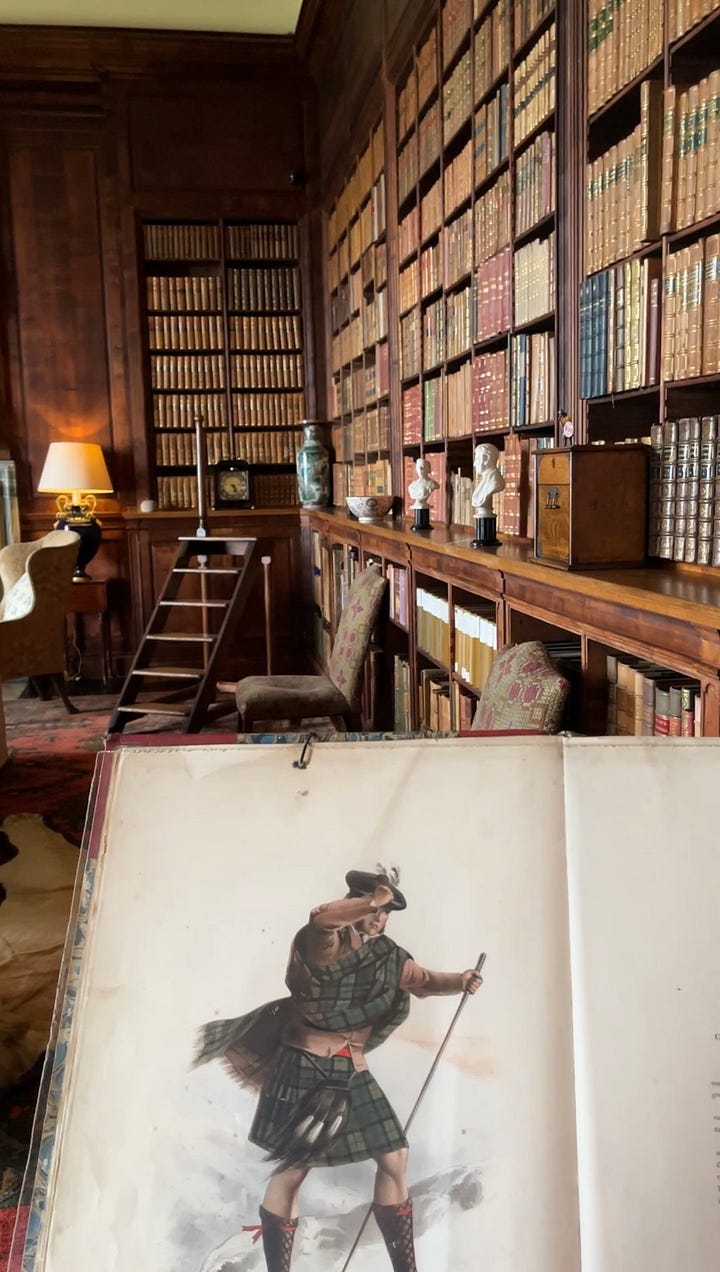Dunrobin Castle, the most northerly of Scotland’s great castles, is a regular feature on TikTok and Instagram as Scotland’s “fairytale” castle. It's not difficult to understand why: Dunrobin is strikingly beautiful, its French-inspired architecture a contrast to the wild coastline, hills, and moors that surround it.
When you visit Dunrobin, you are guided through many of its 189 rooms. It is lavishly decorated with incredible views across its Versaille-esque gardens to the North Sea. The walls are adorned with proud stags-heads, victims of bullets and taxidermy. Each room is lavishly decorated and filled with artefacts, stories, and paintings relating to its aristocratic owners: the earls and countesses of Sutherland.




There is no mention of the Highland Clearances.
What were the Highland Clearances? This event occurred from around 1750 to 1860, and was the forced or “encouraged” eviction of thousands of people from their ancestral homes and lands. This was an absolutely devastating and shameful period in Scottish history which irreversibly impacted the culture and landscapes of the Scottish Highlands, with a disproportionate impact on Gaelic communities.
The Clearances were a result of the collapse of the Highland clan system and the greed of landlords and landed gentry to improve income by replacing the people with the more lucrative option of sheep farming. These evicted Highlanders then became reliant on other industries, such as crofting or kelp-farming, but when these collapsed and poverty and famine set in, were either forced or “encouraged” to leave. Many emigrated away from Scotland, never to return to their homeland again.
Dunrobin Castle is the seat of the earldom of Sutherland, and remains a residence of the Sutherland aristocracy. Although the Clearances occurred across the Highlands—and Lowlands—of Scotland, the particular brutality which occurred in Sutherland is infamous.
While the oldest surviving part of this castle dates to 1401, much of the fairytale that you see today is thanks to extensive renovations carried out in 1845. This means that the aesthetic of this castle came from the profits of the Highland Clearances, which occurred most severely in Sutherland from 1807 to 1821, but continued until around 1850.
You will not read about the role of the Sutherlands in the Highland Clearances when you visit Dunrobin Castle. It is the shameful elephant in the room.
From 1807 to 1821, over 15,000 people were evicted from their homes in inland Sutherland to make way for the introduction of sheep farming, a phenomenon which occurred across Scotland during this time. In Sutherland, this occurred under the order of Elizabeth, Countess of Sutherland.
Elizabeth was married to the wealthiest man in the British Isles, Lord Stafford, but took a personal interest and active participation in the management of her hereditary lands in Scotland. She enthusiastically introduced the Clearances to Sutherland, believing it to be a profitable endeavour for herself as well as a fabulous idea for the poorer communities of the land.
The countess was shocked when her forced evictions of the people of Sutherland were met with resistance. Elizabeth genuinely believed that her plans to take people from their homes and move them to the coast or beyond was helpful and wise, providing them with greater opportunity, and was astonished that the evictees did not agree with her.
The most infamous act of resistance in Sutherland occurred in Kildonan Strath, near Helmsdale, where violence broke out between the people and Elizabeth’s estate factors. One of these factors was Patrick Sellar.
Sellar became particularly infamous for his role in the Clearances when an elderly woman was killed during a forced eviction, after Sellar ordered for her home to set alight. The destruction of roof timbers or the torching of houses were regular methods to ensure that nobody tried to return to their home. Allegedly, Sellar did not know that an occupant remained in the house and attempted to see to her rescue. The woman died a week later from her injuries.
Sellar’s name remains synonymous with the Highland Clearances for his callous approach to the evictions, but he has also been somewhat of a scapegoat for the true architects of what occurred in Sutherland: the Sutherlands themselves.
There is no doubt that Dunrobin Castle, the home of the Sutherlands, is a breathtakingly beautiful castle. By all means, take the pretty pictures and videos in the gardens with those famous fairytale towers behind you. But spare a moment to consider the castle’s true nature: a place of great opulence and extravagance, built on the profited suffering of Highlanders.




Hello Beth,
Indeed I knew some of this story…but reading it in this post makes it all the more difficult. I can see Dunrobin Castle across the water from my home in Dornoch. And while I do appreciate the beauty of the place I also know the troubled history surrounding it, the land and most heartbreakingly the people. Thankyou for writing about this and keeping the spirit of those people alive ……🫀
Wow Beth, it is hard to keep up with your marvelous posts.
The Clearances and The Potato Blight Famine are sort of largely why I am writing to you from Australia; the interesting Scot and Irish diaspora.
And for a while traveled a bit in Sutherland in 1984. Had had a great Journey of the Isles, including being at a Ceiligh (is this correct spell?) on my birthday when, I think, The Cheiftains performed a Brendan Behan poem to music that night, The Auld Triangle.
Deposited in Ullapool as my Aussie mate had to return to work in Aberdeen for about 2 weeks, so relegated to bus and the Postal (not sure if that exists now; travelling shotgun with the postie, and was cheap but expected to help out).
A particularly great stay at Achmelvich youth hostel, which looks as if still going, but a bit more expensive. Saw badgers at night with some Wildlife type people and had some great crab that we cooked up at the hostel.
And the stories about The Clearances at so many places. The best relates to eating some salmon with some fisherpeople I had helped unload. Asked to join for a meal and things.
"Do you mind if it is poached?", I was asked. Said, "I don't mind how it is cooked", at which they laughed.
I did not know of the complex law of salmon ownership which was even then applied especially in Sutherland, and how aggressively processed. A nice meal though, and evidence eaten.
The Castle; jealous of a nice library.
Enjoy your stuff a lot, Cristoffa.